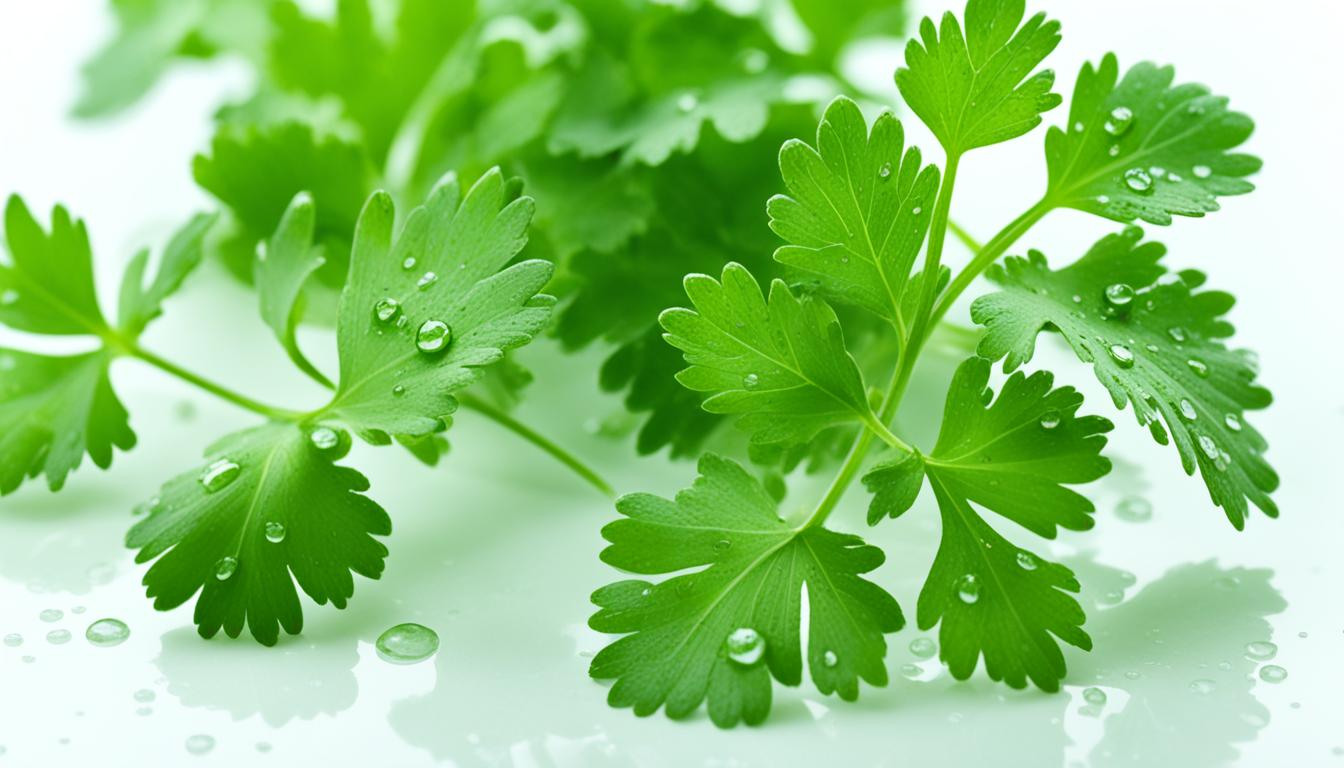I love the bold taste of cilantro in my cooking. It’s the leafy part of the coriander plant. People all over the world use it in their food, from Latin America to Southeast Asia.
Cilantro has a special taste that some people love and others don’t like. It can make a dish taste fresh and bright. For those who love it, cilantro changes the whole meal.
Cilantro is great for making salads, salsas, and stir-fries. Its seeds, called coriander, have a different flavor. We’ll look at why cilantro tastes the way it does, how to use it in recipes, and its health benefits.
Get ready to learn about cilantro’s versatility. It can make your cooking fresh and bold.
Cilantro: Bold, Flavorful, and Versatile
Cilantro is also known as Chinese or Mexican parsley. It comes from the coriander plant. Unlike coriander seeds, cilantro leaves are fresh and have a strong taste. They are key in many global dishes.
People all over the world love cilantro. It’s the most eaten fresh herb. It adds a unique flavor to many foods.
The World’s Most-Widely-Consumed Fresh Herb
Cilantro is known for its bold taste. It’s loved for its ability to make dishes better. It goes well with many foods and flavors.
Fresh Cilantro: The Leafy Part of the Coriander Plant
Cilantro and coriander are not the same. Coriander is the seed of the plant, with a different taste. Cilantro leaves have a strong, soapy flavor.
| Characteristic | Cilantro (Leaves) | Coriander (Seeds) |
|---|---|---|
| Flavor Profile | Assertive, pungent, almost soapy | Warm, citrusy, and nutty |
| Culinary Uses | Widely used in Latin American, Asian, and Middle Eastern cuisines | Commonly used in spice blends, curries, and pickling |
| Part of the Plant | Leafy part of the Coriandrum sativum plant | Dried seeds of the Coriandrum sativum plant |
Cilantro: Love It or Hate It?
Many people love or hate cilantro. Some enjoy its fresh, zesty taste. Others find it soapy. This difference comes from a chemical in cilantro leaves.
Those who notice this chemical find cilantro’s taste bad. They say it tastes soapy. This is because our genes affect how we smell certain chemicals. Up to 14% of people might not like cilantro for this reason.
But, some people don’t feel this way. They enjoy cilantro’s fresh taste. They don’t taste the soapy flavor. It’s all about how our genes work and what we like to eat.
“The aldehyde chemical in cilantro is what makes it taste soapy to some people, but deliciously fresh to others.”
It’s important to understand why people have different views on cilantro. For some, it’s a key ingredient. For others, it’s not liked. We should respect everyone’s taste and find ways to use cilantro that everyone can enjoy.
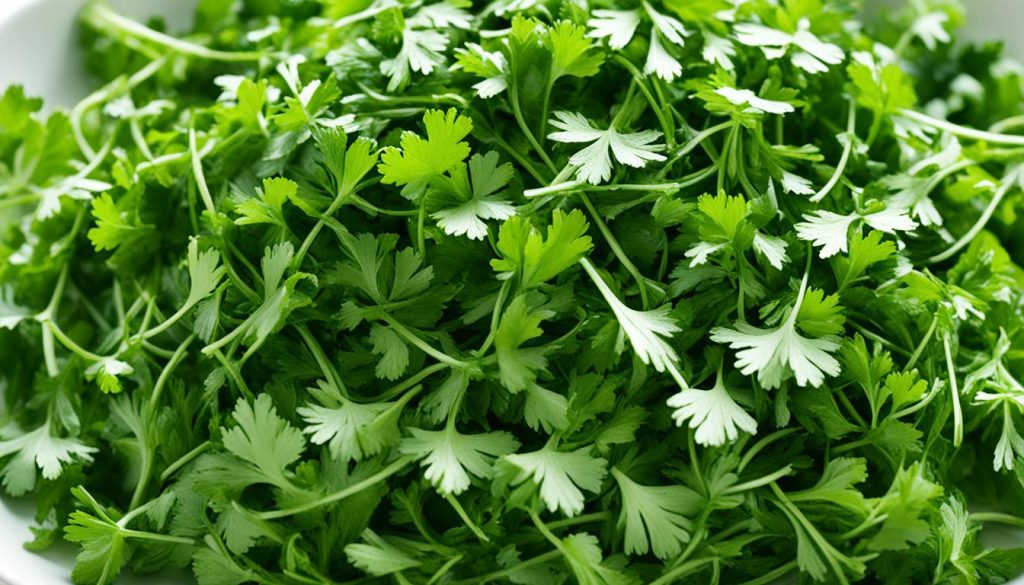
Understanding the Science Behind Cilantro’s Unique Flavor
I love cilantro and always wondered why some people don’t like its taste. It’s all about the aldehydes in it. These compounds make cilantro taste special.
The Aldehyde Factor: Why Some People Taste Soap
Aldehydes are found in cilantro leaves and also in soap and some insects like bedbugs. For many, these aldehydes taste soapy or bad in cilantro.
Our genes affect how we smell these aldehydes. Some people are more sensitive to them. This is why some find cilantro’s taste soapy.
Our taste in cilantro can change as we get older. We might become less sensitive to the aldehydes. This could be why some people start to like cilantro more with time.
“The unique and polarizing flavor of cilantro is due to the natural aldehydes present in the leaves. These same aldehydes are also produced during soapmaking and by some insects, including bedbugs.”
Learning about cilantro’s taste helps us understand why it’s loved or hated. Whether you like it or not, knowing about its flavor can teach us about our taste preferences.
Creative Ways to Use Cilantro in Salads and Salsas
Cilantro is a vibrant and aromatic herb. It can make salads and salsas taste better. Adding cilantro can truly change the flavor.
Chop up fresh cilantro and add it to your salads. It’s great in Mexican-inspired salads with black beans, corn, and lime dressing. The fresh cilantro adds a bright, herbal taste.
Cilantro is also great in salsas. It’s perfect with tomato or mango salsas. The adding cilantro to salads makes your salsa taste amazing. It balances the spices and acidity.
Try different using cilantro in salsas like pineapple or roasted tomatillo salsa. You can mix it in or use it as a garnish. The result is a dish that tastes vibrant and full of flavor.
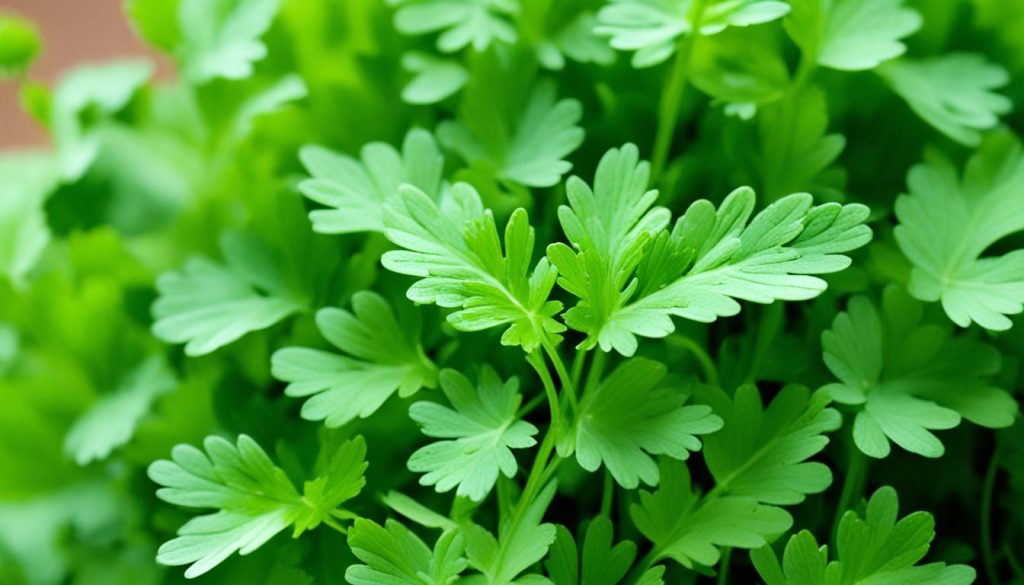
Next time you want to add flavor to your salads and salsas, use cilantro. It’s versatile and can make any dish better. This herb will become a key ingredient in your cooking.
Cilantro: The Ultimate Two-in-One Herb
Cilantro and coriander come from the same plant. They offer a unique taste experience. The fresh leaves have a strong, almost soapy taste. The seeds are smooth, sweet, and sharp.
This mix of flavors is what makes cilantro and coriander special. They are the perfect two-in-one herb.
Coriander: The Seed with a Depth of Flavor
Coriander seeds are great for marinating meats. They add depth to stews and curries. Their flavor is warm and slightly citrusy.
These seeds can be toasted, ground, or used whole. This adds a complex flavor to dishes.
Fresh cilantro leaves are often used as a garnish. They add a bright, vibrant touch. The mix of coriander seeds and cilantro leaves creates a perfect balance.
This balance makes the food taste better. It’s like a symphony of flavors in the kitchen.
“Cilantro and coriander are like yin and yang – they complement each other perfectly, creating a symphony of flavors in the kitchen.”
Whether you’re marinating meats, seasoning stews, or garnishing salads and salsas, cilantro and coriander are essential. They make any spice cabinet complete.
Cilantro in Mexican and Southwestern Cuisine
Cilantro is a must-have in Mexican and Southwestern cooking. It brings a fresh, citrusy taste. This herb matches the bold spices and complex flavors of these cuisines.
In Mexican cooking, cilantro is key for making Mexican salsa and guacamole. It balances the heat from chili peppers and the richness of avocado. This mix of flavors is exciting to eat.
Cilantro also stars in many Southwestern dishes. It adds a refreshing touch to the intense spices. It makes spicy enchiladas and hearty chili con carne taste better.
| Dish | Role of Cilantro |
|---|---|
| Mexican Salsa | Adds a bright, herbal note to balance the heat and acidity |
| Guacamole | Provides a fresh, vibrant counterpoint to the creamy avocado |
| Southwestern Chili | Helps to temper the spiciness and enhance the overall flavor profile |
Using cilantro in Mexican and Southwestern cooking can make your meals taste amazing. It’s great for making zesty salsa or a comforting Southwestern stew. This herb is a true star in the kitchen.
“Cilantro is the glue that holds together the flavors of Mexican and Southwestern dishes.”
Cilantro in Asian and Middle Eastern Dishes
Cilantro is a key herb in both Asian and Middle Eastern cooking. In Asia, it’s often mixed with mint for a fresh taste. This mix is perfect in Vietnamese shrimp and noodle dishes.
Vietnamese Shrimp and Noodle Dishes: A Perfect Pairing
In Vietnamese food, cilantro is a must for shrimp and noodle dishes. It matches well with the sweet shrimp and adds a cool touch. This mix is great in bún chả and bún tôm.
In the Middle East, cilantro is used to add flavor to dishes. It’s often seen in North African tagines and couscous. It also tops mezze platters.
| Dish | Cuisine | Cilantro’s Role |
|---|---|---|
| Bún chả | Vietnamese | Essential herb that enhances the grilled pork and noodles |
| Bún tôm | Vietnamese | Pairs with mint to complement the shrimp and noodles |
| Tagine | North African | Used as a garnish to balance the depth of flavor |
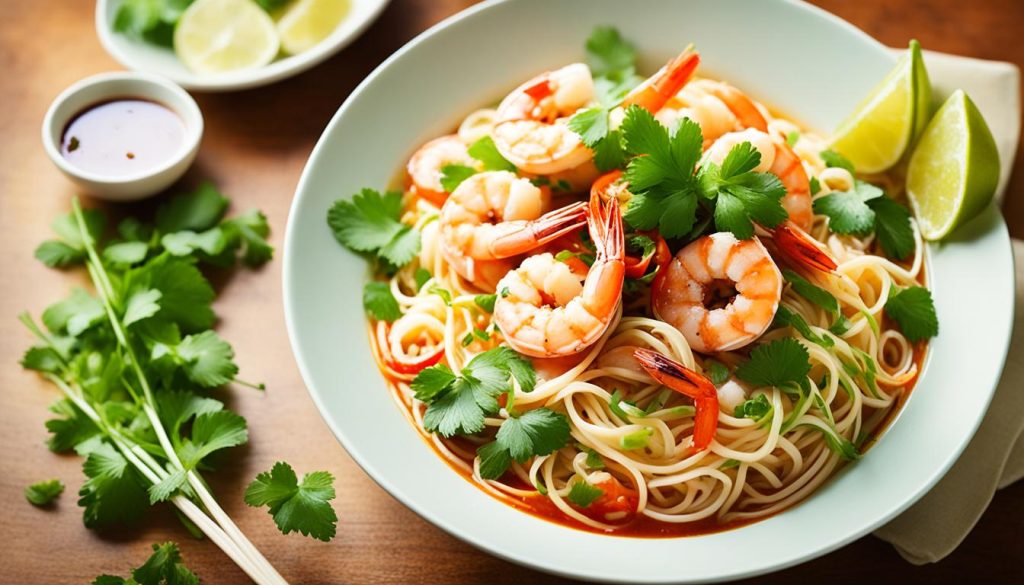
Cilantro is loved in Asian and Middle Eastern cooking for its bold taste. It brings freshness and complexity to many dishes.
Health Benefits of Cilantro
Cilantro is more than just a tasty herb. It’s full of health benefits. This plant is loaded with antioxidants and nutrients that boost our health.
Packed with Antioxidants and Essential Nutrients
Cilantro leaves are full of vitamins A, C, and K. They also have minerals like potassium, calcium, and iron. These nutrients help keep our immune system strong, support bones, and help blood clot properly.
Cilantro is also packed with antioxidants. These fight oxidative stress and lower the risk of chronic diseases.
| Nutrient | Amount per 100g | % of Daily Value |
|---|---|---|
| Vitamin A | 5,142 IU | 103% |
| Vitamin C | 27 mg | 45% |
| Vitamin K | 685 mcg | 854% |
| Potassium | 521 mg | 15% |
| Calcium | 115 mg | 12% |
| Iron | 3 mg | 17% |
Want to boost your immune system, support your bones, or add antioxidants to your diet? Add cilantro to your meals. It’s a tasty and healthy choice. Enjoy the amazing benefits of this herb.
Storing and Preserving Fresh Cilantro
Keeping your fresh cilantro fresh needs a little care. You can store fresh cilantro for days or preserve it for later. There are ways to keep it fresh.
To store fresh cilantro, put the stems in a glass of water. Cover the top with a plastic bag loosely. Put it in the fridge, and it will stay fresh for a week. For keeping cilantro longer, you can blanch the leaves, chop, and freeze them in olive oil. Or, make a cilantro pesto.
You can also make a cilantro compound butter or cilantro salt. This way, you can enjoy its taste for months.
- Store fresh cilantro in a glass of water, covered loosely with a plastic bag, in the refrigerator
- Freeze chopped cilantro leaves in olive oil or as a pesto
- Make a cilantro compound butter or cilantro salt for long-term preservation
Choosing any method is important for storage and preservation of fresh cilantro. This way, you can enjoy its bold taste in your favorite dishes. From salads and salsas to Vietnamese shrimp and noodle dishes.
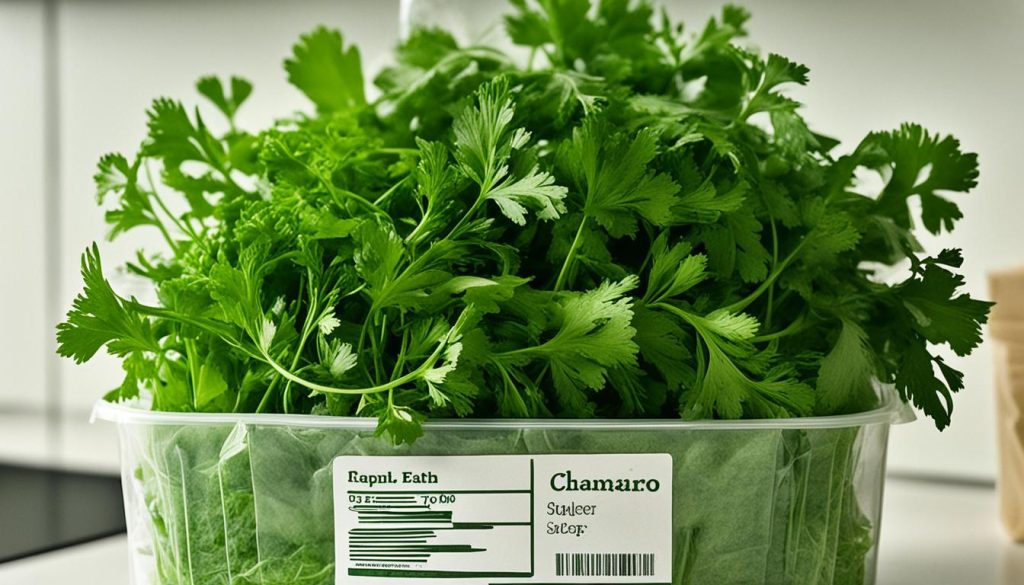
Cilantro: The Herb for Bold, Fresh Flavors
Cilantro changes the taste of many dishes with its bold, fresh flavor. It’s great for making zesty Latin American salsa, fragrant Vietnamese noodle dishes, or Middle Eastern marinades. This herb adds a unique and memorable touch to your cooking.
Cilantro makes dishes taste better by enhancing their main flavors. It adds a refreshing, herbal taste. Its strong, citrusy flavor can cut through rich foods, balance sweet fruits and veggies, and add zing to creamy sauces and dips.
Cilantro is perfect for many dishes, from green salads to spicy tacos. Its taste is like a mix of lemon, pepper, and a bit of sweetness. It works well in both savory and sweet dishes. Use it as a garnish, in marinades, or as a main ingredient to make a dish stand out.
“Cilantro is the unsung hero of the herb world. Its bold, fresh flavors can breathe new life into even the most mundane of dishes.”
When cooking with cilantro, let your creativity flow. Use it in classic Latin American salsas or try new fusion dishes. This herb is key to bringing bold, fresh flavors to your kitchen.
Cooking with Cilantro: Tips and Tricks
When you’re cooking with cilantro, remember a few key tips for the best flavor and freshness. This herb is delicate and tastes best when added near the end of cooking. Adding it too early can make it wilt and lose its bright taste.
A little cilantro can greatly improve your dish’s flavor. Use it wisely, as it can overpower other tastes if not balanced. Keeping the stems in water and refreshing them often helps keep cilantro fresh for a week.
By using these tips and tricks for using cilantro in cooking, you can enjoy its unique taste. Let cilantro add a bold flavor to your dishes and take your cooking to the next level.

